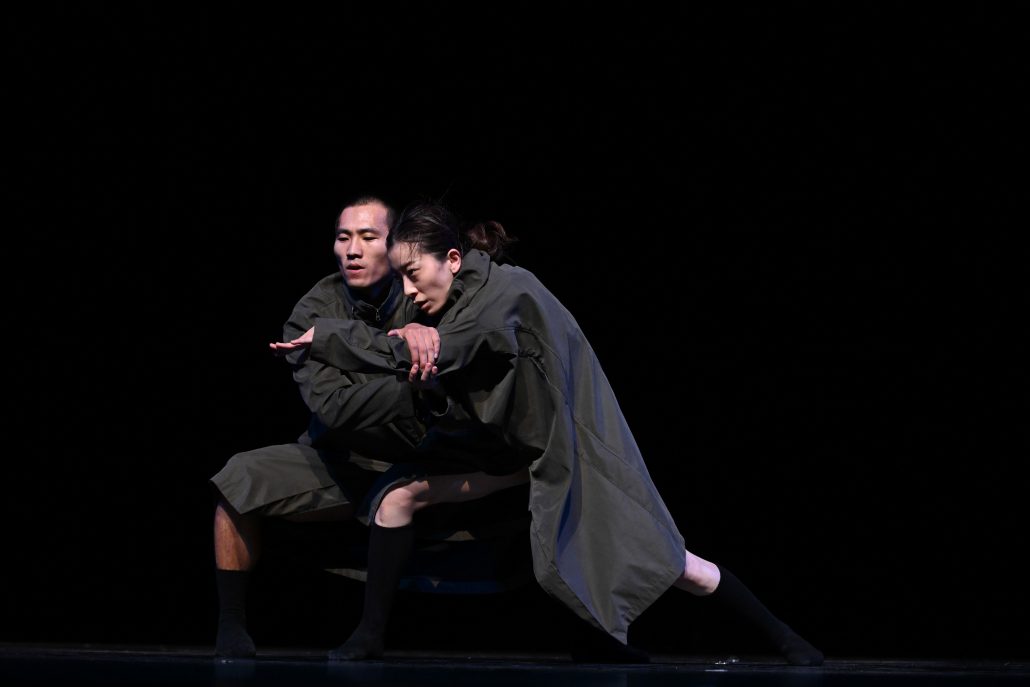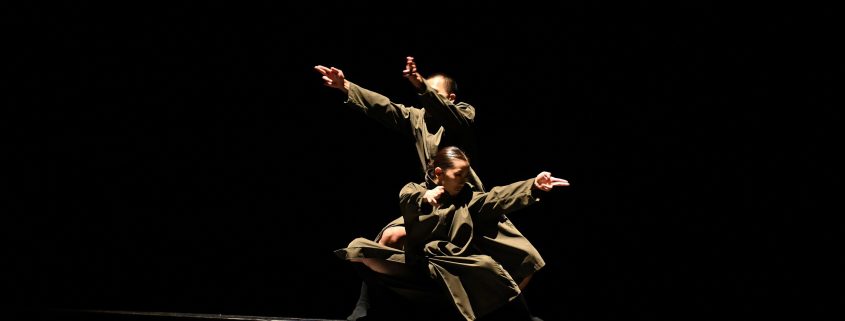STORIES IN DANCE
STORIES IN DANCE
By Norman Warwick
When I led a poetry night, for instance, to raise awareness of homelessness issues in our area, we collaborated with local artists. We collected the rhythmic skills of Pandemonium Percussion with the linguistic artistry of Touchstones Creative Writing Group, the verse-making of Just Poets and the choral abilities of Blackburn Cathedral Choir with the litheness and agility of the CDC dancers.
Contemporary Dance speaks to me in the same way as do other art forms; raising awareness, asking questions and examining answers.

e A special event here on Lanzarote, recently, did all that and more. It gathered together five winning competitors from this year´s 24th Masdanza Canary Islands International Dance Festival, and Teatro El Salinero in Arrecife hosted five dance companies from China, the Netherlands, Vietnam, Italy and Spain.
The Cultural Centre of The Cabildo de Lanzarote was supporting the festival for the eighth consecutive year, and the stage of the theatre was once again covered in linoleum so that the dancers could perform.
Those representing their nations were Xingxing Gong and Mengbo Li from China and Tuan Tran & Joseph Simon from Vietnam and The Netherlands respectively.
Giovanni Leonarduzzi performed representing Italy and four performers, Maddi Ruiz de Loizaga, Adrián Manzano Borrego & Arnau Pérez de la Fuente were from Spain.
Xingxing Gong was the first to perform, presenting Lost, a piece choreographed ´to reflect on loss and encounter.´ The performance began in a darkness illuminated by only a torch, hand held by the dancer in one corner of the stage, and a prop of a lamp-post at the back centre stage. This might have signified that what the dancer was searching for was ´the light´ or a way out of the darkness.
It was her movements and the choreography that signalled encounters throughout a journey towards enlightenment that seemed long and tortuous. None of these encounters seemed in any way to help her, nor to communicate with her or care for her. Instead we saw quite harrowing and even violent intrusions into her life, portrayed by a dance routine of both precision and interpretation that saw Xingxing display great athleticism and supple movements even as she showed herself being man-handled and dragged around.
No other person took to the stage during the piece and we in the audience were left to wonder about how she seemed to be invisible to an uncaring or even afraid-to-care society. Perhaps what we were witnessing was some sort of self-torture created by a paranoia, but her attempts to reach the light seemed genuine and the sense of the oppression she seemed to be feeling was carried, too, by the musical accompaniment. The only sign of any domesticity or permanence here was a changed set of two chairs set face to face under a lamp, in what could have been a household kitchen, or could have been an interrogation cell used by dark forces. Certainly it was around these chairs that the dance was at its most frenzied and frightening.
Whatever was going on in this life-story, the protagonist never ceased in her search for a ´light´ that might have been a metaphor for a truth that was perhaps being withheld from citizens from an unseen but omnipresent ´ruling´ authority.
There was no sense in this opening performance that its young dancer was showing us a character who had found any joy in her life, and this was a pretty harrowing opening, albeit absolutely brilliantly danced and enacted.

Trial, a work by Tu Hoang, was performed by Tuan Tran & Joseph Simon, (see left) This second piece of the night started from a perfect blending, then generated, through very subtle gestures, tension between the two dancers until they clearly evolved towards two well-differentiated identities. In this duet, complexity and synchronicity seemed inseparable when two men move harmoniously together. Quick impulses and detailed hand movements swiftly followed each other in this crystal clear presentation. Homogeneously they find tranquillity in their conformity between each other.
However, small gestures and tensed actions hint at an underlying friction. Boundaries slowly start to appear and gradually grow stronger. In fear of staying behind a battle arises in which they start to compete with one another. Pushing, challenging and ultimately racing till they lose each other and evolve into two separate identities. My own reading of this was not of tensions between two separate males but instead were two male dancers representing the heart and mind of one human being. The tensions revolved around his learning which of the two he might allow to lead and guide him through life. The eventual harmony and synchronicity that body finds shows heart and mind being listened to in equal measure, even if they are offering different advice.
The third show of the night was Sono Solo Tuo Father, by the Italian Giovanni Leonarduzzi, who not only choreographed the piece but also interpreted his own work on stage as an investigation of the nature of violence, guilt, fear, deceit… and the desire to be someone else.
Giovanni´s thoughts on this work were represented in the programme notes.
´Through my body I tell the story that happens every day. It´s a story of silent violence where guilty feelings nourish and feed, cultivate and breed. Where filthiness and shame are thrown upon you. I guess only dogs like to vomit. I speak about the violence which tastes as lies, about the wickedness which can change your shape. Because it is convenient to see me like this.´
The choreographer and dancer further explained in his notes that ´I dance the violence of turning my fears into reality. Let me turn solid and leave me here so you can curse me. A hymn to the misery and poverty of my art, of my visions, where before there was wonder. Violence discredits. Violence scorns. Because the way they say it is as I would say it. Because to be hated it is enough to have the desire and the will to be something else. But I AM JUST YOUR FATHER and I would love to be seen through my mistakes and through everything I have never done. But if there´s something that I know, it is that I love you. Hence in this filthiness I smile because I miss you.´
This dance opened with its protagonist centre stage, in a static position. In the expectant silence my wife, Dee, whispered to me that this was what is called The Plough position, and then whispered triumphantly that she can do that, and often does, at her yoga classes. Perhaps I didn´t look suitably impressed in the darkness of the theatre, so she continued to tell me that is a very dangerous position, because it basically means sitting on your head, and that to do this a person must remain perfectly still because one wrong move could seriously damage the back or neck. As she told me this I looked at the male dancer who was stripped to the waist, and I realised that from my front row seat I couldn´t actually be sure whether I was seeing him from the top down or from the bottom up, which reminded why I never join my wife and her lady friends at their yoga group.
Just as I was absorbing Dee´s warning about drastic body injuries, the prone dancer moved. First, he put his arms out along the floor at either side of him, then began tapping his hands out on the floor. Then he sort of bent over from the hips, wherever they were, and leaned to one side.
I could almost hear muscles tearing and bones creaking, but suddenly he sprang to his feet, and for the next few minutes strutted his stuff all across the dance floor.
Giovanni was a charismatic and engaging performer. There was the faintest of notions, though, that he was, deliberatyely, too knowing: too aware that he could hold us in the palm of his hands, as performers so often do.
Whether we were seeing the real Giovanni Leonarduzzi or an actor of that name playing, and embellishing, the role of his own self became a blurred issue, and invited us, instead, to consider whether the role of a father is an all-consuming responsibility or can actually leave room to create a wider identity.

The fourth of tonight´s offerings, was a piece created by Xingxing Gong and performed in collaboration with Mengbo Li. With music by Ara Malikian, both dancers reflected, as I believe Tuan Tran & Joseph Simon had in their presentation of Trial, on how the power of the human being is in the control of the soul over the heart and mind and body. Only a soul that can reconcile or free itself from that tyranny has the power to control and transform the surrounding environment. The piece seemed to address gender issues too, with the male character being physically stronger and exerting a bullying nature. This seemed to me to explore the nature of death and the point at which death occurs, with a suggestion that losing the will to live or deciding not to ´fight back´ might be seen as ´time of death.´
Too soon, really, the night was closed with Young Blood, by Arnau Pérez de la Fuente.
He himself and Maddi Ruiz de Loizaga and Adrián Manzano Borrego told a story, through dance, accompanied by contemporary rock music and hip hop that introduced us to a generation of young people eager to make their way in, and make a difference to, this world, but who find their expectations constantly truncated by ´The Man´ and the current state of society.
´Young Blood, we see you,´ states a voice over a loudspeaker, in a tone that suggests not admiration but disapproval. This young generation, full of energy, creativity and desire to develop new paths, is prevented from doing so by an established but perhaps slightly fearful, older society.
The young have so much to say and reclaim in every place but realise they are being watched. There is in this dance a sense of preparedness and intent. Everybody is watching everybody else, waiting for the first move, but nobody knows what that first move might be or whether they are ready for it.
How wonderful it might have been tonight, for this good sized and seemingly very knowledgeable audience including, I´m sure, many practitioners of varying levels, to have heard a dancer or choreographer explain something more of the stories we were being told.
My own responses, perhaps over-stretched interpretations, come about partly because of my lack of expertise in dance choreography or performance. When working with Can´t Dance Can in Rochdale I saw at first-hand what joy contemporary dance can bring to individuals and communities and how it can be a force for social cohesion. From that I know how powerful dance can be as a story-teller and also know that part of the fun and the challenge of contemporary dance lies in the telling and receiving of stories like those so sublimely delivered here at the El Solinero.
Look out for our next two posts that further examine the concept of contemporary dance, as we take at Dance United Yorkshire and then create an exclusive Sidetracks & Detours playlist: Dance With Me.




Leave a Reply
Want to join the discussion?Feel free to contribute!